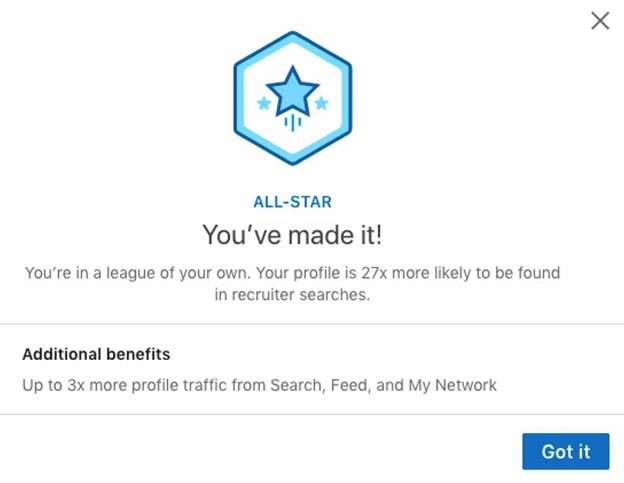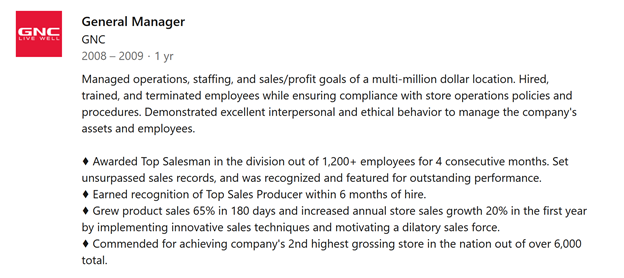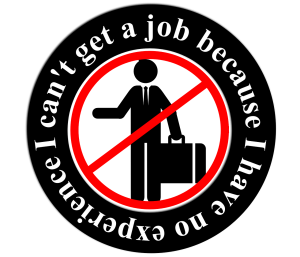How To Create A LinkedIn Profile That Lands Interviews
So you’re looking for a new job. You’ve been doing your research, and you know that in order to find the perfect opportunity, you need more than just a solid resume to land interviews – you need to have an updated LinkedIn profile that reflects your achievements and highlights your value to prospective employers. We know that professional photos, headline writing skills, keywords, and personalized messaging are important, but what all should this include, and where do you start?
Here are some quick and effective ways to optimize your LinkedIn profile to stand out, WOW recruiters, and land more interviews.
A Professional Headshot (Profile Picture)
Adding a professional photo to your LinkedIn profile is key to boosting your visibility on the site. In fact, LinkedIn says that you’ll get 21 times more profile views with a picture than without one.
Your profile photo should be square, 400×400 pixels, and ideally taken by a professional photographer. But if you don’t have a few hundred dollars to shell out for a photography session, you can get away with something less formal if you follow these best practices:
• Smile. It makes you seem more approachable.
• Choose a solid—or otherwise non-distracting—background.
• Avoid full-body or head-only shots. Show your head and shoulders.
• Choose something recent that shows what you look like now—not 10 years ago.
Choose an appropriate photo of yourself; avoid pictures from any time before high school or photos where only your face is shown. The goal of this photo is to show your professional and mature side, not a glamour shot from your college days.
Headline (Your LinkedIn Profile Name)
The overall purpose of your LinkedIn headline is to tell everyone on LinkedIn who you are, what you do, and why you’re someone with whom they need to connect.
You have only 220 characters to write your LinkedIn headline, so it is vital to maximize each one. You should use as many characters as you can to increase the opportunity to be found. By default, LinkedIn uses your existing job title as your profile headline. However, since your headline is often the only piece of information other than your name and location that appears in search results, you are better off writing an enticing headline that encourages recruiters to click through to see your full profile.
Plus, a custom headline differentiates you from the millions of other “Marketing Manager,” “Product Manager,” and “Software Developer” profiles on LinkedIn.
Customizing your headline also gets you to All-Star status (assuming you’ve completed all of the steps listed in this article), which, according to LinkedIn, makes your profile 27x more likely to appear in recruiter searches.

You should aim to be client/customer-centric when crafting your headline. This means highlighting pertinent skills and making it easy for people to find you.

Winning LinkedIn headline formula:
What you do | Adjective or phrase on why you do what you do | Adjective or phrase on what differentiates you from others | Descriptive words on what you bring to the table.
Nailing Your Professional Summary
LinkedIn asserts that “summary is the #1 thing recruiters look at when viewing profiles.” This means the summary section is key to boosting your visibility on the site. If it’s the first thing recruiters look at, it might be your only chance to grab their attention and encourage them to stick around for a while and learn more about you.
Focus on one or more of the pieces of information below to tell a story about your career that stands out:
• Significant career accomplishments
• Your values and passions
• Your “superpowers” (things you do better than anyone else)
• Verifiable facts and statistics
• What makes you different and unique
• Social proof via quotes and testimonials

Speak the language of your target clients and prospects; use terms they might use in their searches..
If your headline isn’t doing this, then you are losing opportunities for effectively branding yourself and landing new opportunities. Plus it costs nothing to customize it!
Share Measurable Achievements (In addition to Job Duties)
The experience section is the part of your LinkedIn profile that’s most like your resume, but it doesn’t have to be a straight copy-and-paste exercise. Most recruiters will eventually see both your resume and LinkedIn profile, so the better approach is to have the two complement—rather than replicate—each other. Just make sure that positions and dates are consistent across both.
With one position listed on LinkedIn, you’re likely to get up to eight times more profile views. And with more than one position listed, you’re profile gets viewed up to 29 more times.
The most standard approach is a bulleted list of responsibilities and accomplishments for each role. Note: LinkedIn doesn’t have a WYSIWYG editor that makes it easy to add bullet points, but you can do this by typing Alt + 0149 on a Windows machine, or option + 8 on a Mac.

Avoid simply pasting your job duties in each employment section. Instead, talk about what you’ve accomplished and what it meant for your employer or the team you worked with. Listing quantifiable achievements throughout your work experience is a great way to highlight the impact you had and the results you are capable of producing.
Example: “Managed a budget of $XXX” OR “Reduced costs by XX% through…”
List Relevant Skills
According to LinkedIn, people with at least five skills listed on their profiles get as much as 17x more profile views and up to 31x more messages from recruiters.
LinkedIn will recommend skills for you based on your education and experience, so you can quickly select those or search for other skills that aren’t auto-recommended. Either way, be sure to choose from LinkedIn’s prewritten skills—recruiters use these to filter candidates—unless there’s no matching prewritten skill.
Pro Tip: If you’ve had a profile on LinkedIn for a long time, you may have added your skills by typing them in manually instead of choosing from the newer prewritten skills. If so, you should go back in and refresh your skills using the new prewritten terms in order to appear in recruiter searches filtered by LinkedIn’s skills list.
Once you have skills listed, you need to get endorsements for those skills. Studies have shown that having endorsements for your skills significantly improves your search rankings.
Finally, make sure you have your endorsement settings set to Yes to get LinkedIn to automatically prompt your connections to endorse you for your skills. To check/edit these settings, go into the skills editing view, click Adjust endorsement settings, and toggle the switches for all of the options to Yes.
Conclusion
We tend to only think of LinkedIn when we’re actively looking for work, but there’s value in keeping your profile fresh and staying active on the site even when you’re just passively looking—or not looking at all.
By following these tips and keeping your LinkedIn profile up to date, you’ll be able to take advantage of the site for more than job hunting, using it to grow your network, expand your connections, and build your business or personal brand.
You can check out more LinkedIn tips and guidance here.
Still not sure where to start? Drop us a line below to see how our LinkedIn Branding Specialists can help you today.
8 Résumé Writing Tips for 2017
So, you’re looking for résumé writing tips. Naturally, you do what every sensible person in this day and age does. You get on Google. Except you’ve been on Google for 3 days straight now. You have clicked through hundreds of links and have been through about 4.369 trillion templates (give or take a few). Well, it doesn’t matter if you are part of the 7.8 million unemployed Americans or if you are looking to move up in the world of business because there is arguably only one correct format. But why should you trust us? Short answer, you shouldn’t; you should trust the research, though.
Before I just start pelting lists of things about what your résumé should be/have, first we should go over what a résumé is.
Résumé Writing Tip #1: Trust the research (find what works and use it)
What Makes a Résumé?
Mr. Manager needs employees. Accordingly, he puts out an advertisement for a job opening. You see this ad and you go in and drop off your résumé. But why should he pick you? Your face contorts and your brow lifts as you say “Because he’s hiring. Duh.”
Fair enough, but humor me for a second. As I stated before, there are 7.8 million unemployed people in America. Maybe, just maybe, there are other applicants that have applied. So, not only do you have to apply for jobs, but you also have to be better than the competition, maybe a lot of competition.
Experience
Your résumé is your highlight reel. It tells Mr. Manager why you deserve the job. But why do you deserve the job? Before you start on your résumé, do you know what you bring to the table? Start out by listing the experiences you have.
Your arms fly into the air in obdurate frustration “But I don’t have any experience. People aren’t hiring me because I don’t have experience and I can’t get experience because people aren’t hiring me!”
Funny how that works, huh? Even if you don’t think you have experience, don’t sweat it. Chances are, you have done much more than you think you have. Maybe you were a summer camp counselor or you were a group leader for some preschoolers you watched one day. Well, guess what? That’s leadership experience. That goes on you résumé. Don’t be shy about what you have accomplished either. Put that in there. Relevant coursework, additional training, volunteer work, and/or extracurricular activities? That goes in there too. See, we told you that you’ve done more than you think you have.
Résumé Writing Tip #2: Non-traditional experience can still be experience, and it belongs in your résumé
Formatting
Now that we have the experience content figured out, let’s move onto format. The majority of the research shows most hiring managers like to see traditional résumés that consist of a parallel construction with concise bulleted lists (Diaz, 429). Well, that’s fancy, but what does it mean? It means that your résumé has to be organized and pleasing to the eye. Basically, it shouldn’t be a jumbled mess of garbage.
Résumé Writing Tip #3: No out of the box designs or crazy formats (stick to the basics)
Résumé Writing Tip #4: Write with a parallel construction with concise bulleted lists
Data, Devil, Details

Hiring managers also analyze résumés in an F pattern as they sweep across the page (Nielsen, 2006). The most important information needs to be located at the top and along the left side of résumé. Your name and positions should be listed in large, bold font to catch the manager’s attention. Dates and locations aren’t as important and can, therefore, be minimized.
Keep in mind that Mr. Manager has to potentially review dozens or maybe even hundreds of résumés. As you can imagine, this is time-consuming. He isn’t going to read every single thing on your résumé. Specifically, it is the first eleven characters are the most important of every line (Nielsen, 2009). These are the characters most hiring managers read before deciding whether or not to finish the line or to move on to the next one. For this reason, you should try to start every line with a strong action verb and try to put the most important information in the first eleven characters.
Resume Writing Tip #5: Enlarge and bold your name and positions
Résumé Writing Tip #6: Put the best/most important information in the top left of the résumé
Résumé Writing Tip #7: Make every line count (first 11 characters)
Cover Letter
Though not technically part of your résumé, taking the time to create a customized cover letter or objective to match the job for which you are applying will help you stand out from the other candidates. However, there are caveats. For example, a cover letter or objective isn’t useful in a broad résumé, as it can narrow your search too much and turn off potential employers (Bennett, 339). If you decide to include one, it must be worded in a way that will relate your qualifications and experiences to the specific needs of the employer. If your cover letter isn’t targeted to a specific position, it doesn’t matter if your résumé is put together perfectly. It won’t receive the responses you want and that won’t get you your dream job.
Résumé Writing Tip #8: In your cover letter or objective, be specific to what is asked for and described in the job listing
We have helped clients with a diverse set of backgrounds, including high-level executives and CEOs. We have a 93% client success rate (interviews landed and jobs secured) and a 98% client satisfaction rate. Our writers have over 20 years of experience in numerous fields and have written over 100,000 résumés.
Hopefully, these résumé writing tips have helped you. If you have any questions or are interested in our assistance while you’re writing, follow the link below to speak with an expert today:
Sincerely,
Respected Résumés
Citations & Sources for Résumé Writing Tips
Bennet, S. (2005). The Elements of Résumé Style: Essential Rules and Eye-opening Advice for Writing Résumés and Cover Letters That Work. Business Communication Quarterly. 69. 339-354.
Diaz, C. S. (2013). Updating Best Practices: Applying On-Screen Reading Strategies to Résumé Writing. Business Communication Quarterly, 76, 427-443.
Nielsen, J. (2006, April 17). F-shaped pattern for reading web content.
Nielsen, J. (2009, April 6). First 2 words: A signal for the scanning eye.
How to Start Writing Your Résumé
Where Do I Start?
Blink. Blink. Blink.
You know that terrible feeling you have when you stare at a blank Word document for hours because you don’t know where to get started? You start scrolling through Facebook or other social media to avoid the dread. We all hate that feeling. You know it’s really important, but you don’t know what to put down.
Writing a résumé is a daunting task. It’s all the Hiring Manager will have to gauge you on. This piece of paper will represent your work ethic, education, intelligence, and personality. Many résumé writing services will try to sell you on the fact that you have to make your résumé unique in order to stand out. While we agree that being unique does help you stand out; it may not help you stand out in the right way.
What Is It Supposed To Look Like?
There is an accepted standard format to how résumés are set up. This is what Hiring Managers prefer and are looking for. They are looking and hundreds maybe even thousands of applications. So, they are trying to filter through them as quickly as possible. There is a method to how these Hiring Managers will look at your résumés. If you diverge from the accepted standard format, they have to spend more time looking at your résumés, which will frustrate them. This will decrease your chances of getting shortlisted.
Your résumé should be formatted to be in an “F-pattern” with short, concise bullets that highlight your most pertinent job responsibilities with quantifiable accomplishments. In this format, the Hiring Manager can skim across the top to see your name and education. Then they will move down the left side of the page to see your most relevant position and read the next 11 characters of each bullet. This is why you must maximize the density of your information content by being as concise as you can.
Want Help?
As you can tell there are many aspects you must consider when designing your résumé. The experts at Respected Résumés can help you get started on the right track or even design a custom résumé tailored just for you.
If you have any questions or are interested in our assistance while you’re writing, follow the link below to speak with an expert today:
Speak With An Expert
Sincerely,
Respected Résumés

